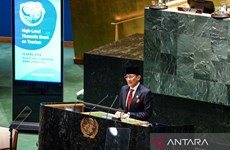Japan: radiation normal at Fukushima plant
The International Atomic Energy Agency (IAEA) reported on February 14
that radiation levels at the Fukushima Number One Nuclear Plant were
normal after the number three reactor exploded earlier in the day.
The International Atomic Energy Agency (IAEA) reported on February 14
that radiation levels at the Fukushima Number One Nuclear Plant were
normal after the number three reactor exploded earlier in the day.
The explosion injured 11 people, however the radiation container was not breached, causing no major leak of radiation.
The blast was caused by a build-up of hydrogen in the building around the No. 3 reactor at the Fukushima Number One plant, said chief government
spokesman Yukio Edano.
He confirmed that there was no major rise in radiation and quelled concerns over possible harm to human health caused by radiation.
This was the second explosion at the nuclear plant after the first hit the No. 1 reactor on March 12.
The Japanese Nuclear and Industry Security Agency (NISA) reported that the cooling system at the No. 3 reactor failed before the explosion. Jiji news agency reported the failure of the cooling system of the nuclear plant’s No. 2 reactor on March 14. The Tokyo electricity company (TEPCO) was attempting to remove residual heat to cool the reactor.
On the same day, the Bank of Japan (BOJ) announced its plan to pump 18 trillion Yen (roughly 220 billion USD) to the monetary market amid fears that the devastating earthquake on March 11 might cause serious problems to commercial banks and financial institutions in the world’s third largest economy.
Of the sum, 15 trillion Yen is to be disbursed immediately and the remaining 3 trillion Yen will be injected into the monetary market on March 16 to help financial institutions to provide short-term loans.
Foreign countries continued to extend offers of help with post-quake rescue. China sent a 15-strong rescue fleet to Iwate province, which was battered by the disaster. Russia has also announced the departure of two rescue teams, consisting of over 70 people, for Japan . The Republic of Korea said it would transfer a quantity of liquefied gas to Japan to ease the shortage of energy there. RoK President Lee Myung-bak said his nation would send an additional 102 rescuers to Japan .
Other countries, including Cuba , Finland , Latvia , Mongolia , Bangladesh , Sri Lanka , also offered assistance in rescuing earthquake victims in Japan .
The earthquake measuring 9.0 on the Richter scale rocked Northeastern Japan on March 11, and along with a devastating tsunami, claimed almost 1,900 lives and left 20,000 missing, according to the latest reports released on March 14.
A strong aftershock measuring 5.8 on the Richter scale hit the eastern coast off Honshu island on March 13. However, no tsunami warning was released. Japanese weather forecasters warned of other aftershocks measuring about 6.0 on the Richter scale expected to hit the country within the next couple of weeks./.
The explosion injured 11 people, however the radiation container was not breached, causing no major leak of radiation.
The blast was caused by a build-up of hydrogen in the building around the No. 3 reactor at the Fukushima Number One plant, said chief government
spokesman Yukio Edano.
He confirmed that there was no major rise in radiation and quelled concerns over possible harm to human health caused by radiation.
This was the second explosion at the nuclear plant after the first hit the No. 1 reactor on March 12.
The Japanese Nuclear and Industry Security Agency (NISA) reported that the cooling system at the No. 3 reactor failed before the explosion. Jiji news agency reported the failure of the cooling system of the nuclear plant’s No. 2 reactor on March 14. The Tokyo electricity company (TEPCO) was attempting to remove residual heat to cool the reactor.
On the same day, the Bank of Japan (BOJ) announced its plan to pump 18 trillion Yen (roughly 220 billion USD) to the monetary market amid fears that the devastating earthquake on March 11 might cause serious problems to commercial banks and financial institutions in the world’s third largest economy.
Of the sum, 15 trillion Yen is to be disbursed immediately and the remaining 3 trillion Yen will be injected into the monetary market on March 16 to help financial institutions to provide short-term loans.
Foreign countries continued to extend offers of help with post-quake rescue. China sent a 15-strong rescue fleet to Iwate province, which was battered by the disaster. Russia has also announced the departure of two rescue teams, consisting of over 70 people, for Japan . The Republic of Korea said it would transfer a quantity of liquefied gas to Japan to ease the shortage of energy there. RoK President Lee Myung-bak said his nation would send an additional 102 rescuers to Japan .
Other countries, including Cuba , Finland , Latvia , Mongolia , Bangladesh , Sri Lanka , also offered assistance in rescuing earthquake victims in Japan .
The earthquake measuring 9.0 on the Richter scale rocked Northeastern Japan on March 11, and along with a devastating tsunami, claimed almost 1,900 lives and left 20,000 missing, according to the latest reports released on March 14.
A strong aftershock measuring 5.8 on the Richter scale hit the eastern coast off Honshu island on March 13. However, no tsunami warning was released. Japanese weather forecasters warned of other aftershocks measuring about 6.0 on the Richter scale expected to hit the country within the next couple of weeks./.












